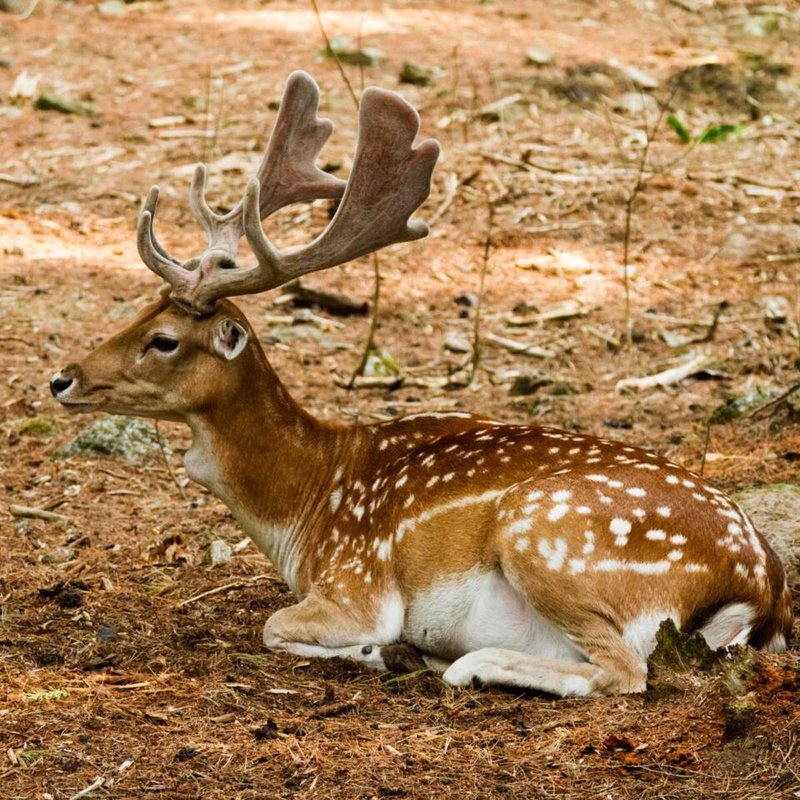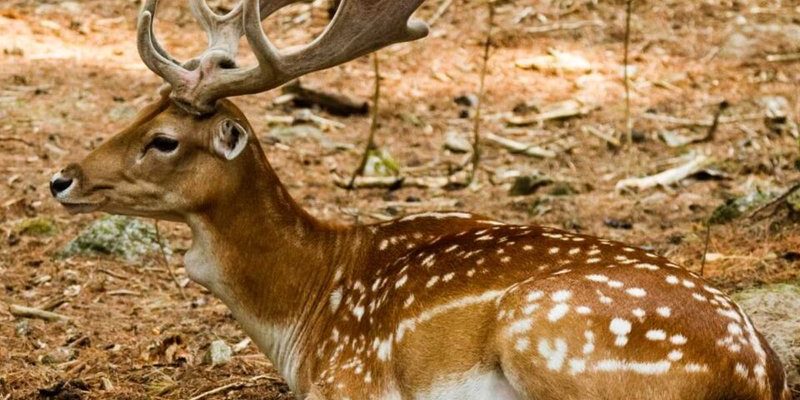
In this article, we’ll dive into the top ten fascinating facts about fallow deer. Think of it as a cozy chat over coffee—just us exploring what makes these animals so unique. You might be surprised by what you learn!
1. Unique Appearance
Fallow deer are instantly recognizable thanks to their beautiful, spotted coats. The spots are especially prominent in the lighter color variations, which can range from a rich chestnut to a pale creamy hue. Honestly, they look like nature’s own artwork, painted with thoughtful splashes of white.
These deer also have a distinct set of antlers that separates them from other deer species. Instead of branching upwards like a typical tree, their antlers grow flat and palm-shaped with multiple tines. This unique shape isn’t just for show; it’s a mark of maturity. Only male fallow deer, called bucks, develop these extravagant antlers, which they shed and regrow every year.
You might be wondering how these attributes help them survive. The spotted coat acts as natural camouflage among the dappled light of the forest, helping them escape notice from predators. Meanwhile, their impressive antlers play a role in attracting mates during the breeding season—a feature that has evolved over thousands of years.
2. Origin and Distribution
The story of the fallow deer begins in the Mediterranean region, particularly in countries like Greece and Turkey. They’ve been roaming our planet for thousands of years, finding their way across Europe, Asia, and eventually to the British Isles. Nowadays, you’ll spot them in parks and reserves not just in Europe but also in New Zealand and Australia due to successful introductions.
Here’s the thing: fallow deer are adaptable animals. They thrive in various environments, from woodlands to grasslands. This versatility is one reason they’ve managed to establish populations across different continents. You may see them wandering peacefully in fields, contributing to the local ecosystem by grazing on grasses and shrubs.
Their ability to thrive in various habitats makes them quite a fascinating species. Unlike other deer species that might struggle with urbanization, fallow deer often flourish in park-like settings where they can interact (and sometimes clash) with humans.
3. Social Creatures
Fallow deer are social animals that enjoy living in groups, known as herds. Depending on the season, these herds can vary in size. In warmer months, you might find them gathering in larger groups, often consisting of females and their young. Males, on the other hand, tend to be more solitary during this period, establishing their territory and competing for the attention of females.
When autumn rolls around, things take a different turn. This is the breeding season, or rut, when the bucks become more social and aggressive. They strut around, showcasing their impressive antlers, and engage in sparring matches with others to assert dominance. It’s like a nature competition that plays out right before our eyes, and it can be quite exciting to witness!
Building bonds within their herds helps ensure safety in numbers. If a predator threatens, the group can scatter, increasing their chances of survival. It’s a classic example of “there’s safety in numbers” at work in the animal kingdom.
4. Diet and Feeding Habits
Now, let’s talk about what fallow deer like to munch on. These animals are herbivores, which means they eat plants. A fallow deer’s diet primarily consists of grasses, leaves, fruits, and even some tree bark. They’re selective feeders, preferring tender young shoots, and they can be quite picky.
You might be surprised to find out that fallow deer are known for their ability to adapt their diet based on the season. In spring and summer, they feast on fresh vegetation, while in autumn and winter, they may switch to acorns and other hard seeds. This flexibility helps ensure they find enough food throughout the year, even when conditions change.
Interestingly, fallow deer have a unique way of processing food. They have a digestive system that allows them to extract the maximum nutrients from their meals—a talent that helps them stay healthy and energetic. If you think about it, it’s similar to how we might meal prep to stay on top of our health, just on a deer-sized scale!
5. Communication Skills
Fallow deer might seem quiet at first glance, but they have a whole range of communication skills. They use a combination of vocalizations, body language, and even scents to convey messages to one another. For example, during the rut, bucks often grunt and make different noises to attract females or warn rival males.
Their body language is equally important. You might notice a deer raising its head or flicking its ears, which can indicate curiosity or alertness. And let’s not forget about their impressive sense of smell. They have scent glands on their hooves and faces, which they use to leave scent markers that communicate various messages within their territory.
Have you ever tried to guess what a dog is thinking based on its wagging tail? In a way, it’s similar with fallow deer. Their ability to communicate is crucial for maintaining social bonds and establishing hierarchies within their herds.
6. Breeding and Offspring
When the mating season arrives, fallow deer engage in quite a dramatic ritual. The bucks work hard to win over females, showcasing their antlers and calling out with deep grunts. This can lead to intense competition between males, where they engage in sparring to show off their strength and dominance.
Once a female, or doe, chooses her mate, she typically gives birth to one or two fawns in late spring or early summer. These fawns are born with their iconic spots, which provide effective camouflage against predators. It’s a bit like nature’s way of giving them a stylish, protective outfit.
For the first few weeks of their lives, fawns rely heavily on their mothers, staying close and nursing. As they grow, they begin to explore their surroundings and start nibbling on plants. This time is critical for their development, as they learn essential survival skills from their mothers before becoming more independent.
7. Conservation Status
Fallow deer are generally not considered endangered, and their populations are stable in many areas. However, like many wildlife species, they face threats from habitat loss and hunting. It’s essential to strike a balance between conservation efforts and the needs of local communities.
Conservation programs in various parts of the world are focused on preserving the natural habitats of fallow deer while promoting responsible hunting practices. In some regions, they’ve become quite a popular species for wildlife tourism, helping foster appreciation and understanding of the importance of biodiversity.
By supporting sustainable practices, we can ensure that future generations will continue to enjoy the sight of these magnificent creatures in their natural habitats. It’s a reminder that our actions today can shape the world of tomorrow.
8. Cultural Significance
Fallow deer have long held a special place in human culture, appearing in folklore, art, and even heraldry. In many ancient cultures, they were symbols of grace and beauty. They’ve also been featured in paintings and literature throughout history, often representing themes of nature’s elegance.
In some regions, fallow deer are associated with hunting traditions, and they play a significant role in local customs. Festivals and events celebrating the harvest season may include fallow deer as a focal point, showcasing their importance to cultural heritage.
Understanding the cultural significance of fallow deer helps us appreciate their role beyond just wildlife. They connect us to the past and remind us of our relationship with nature—something that deserves our respect and protection.
9. Fun Facts About Fallow Deer
Let’s wrap up with some quick, fun facts about fallow deer that you might not know:
- Color Variations: Fallow deer come in different colors, including white, black, and a spotted variation, which makes them visually diverse.
- Silent Retreat: When threatened, they can remain completely still, blending into their surroundings to avoid detection.
- Long Lifespan: In the wild, they can live for about 10 to 15 years, but in protected environments, some live even longer.
- Unique Hooves: Their hooves are split, which helps them navigate various terrains, from soft grasslands to rocky areas.
These little tidbits add to the charm of fallow deer and make them even more interesting to learn about.
10. How to Spot Fallow Deer
If you’re eager to see fallow deer in the wild, there are a few tips to improve your chances. They’re most active in the early morning and late afternoon when they come out to graze. Look for them in wooded areas, parks, or pasturelands where they can hide among the trees.
When you’re out exploring, keep noise to a minimum. The quieter you are, the more likely you’ll spot them. You might be lucky enough to see a group of does with their fawns or witness a sparring match between bucks during the rut.
Remember, patience is key. Just like searching for hidden treasures, spotting these beautiful creatures can be rewarding if you take the time to observe and enjoy nature’s wonders.
In conclusion, fallow deer are not just charming animals with stunning looks; they’re a complex species with rich behaviors, social structures, and cultural significance. Whether you’re a nature enthusiast or just curious about wildlife, understanding these fascinating facts about fallow deer can deepen your appreciation for the natural world. So next time you find yourself in a forest or park, keep an eye out—you never know when you might catch a glimpse of these graceful creatures!

